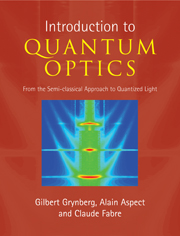Book contents
- Frontmatter
- Contents
- Foreword
- Preface
- Acknowledgements
- Part I Semi-classical description of matterlight interaction
- Part II Quantum description of light and its interaction with matter
- 4 Quantization of free radiation
- Complement 4A: Example of the classical Hamiltonian formalism: charged particle in an electromagnetic field
- Complement 4B: Momentum and angular momentum of radiation
- Complement 4C: Photons in modes other than travelling plane waves
- 5 Free quantum radiation
- Complement 5A: Squeezed states of light: the reduction of quantum fluctuations
- Complement 5B: One-photon wave packet
- Complement 5C: Polarization-entangled photons and violation of Bell's inequalities
- Complement 5D: Entangled two-mode states
- Complement 5E: Quantum information
- 6 Interaction of an atom with the quantized electromagnetic field
- Complement 6A: Hamiltonian formalism for interacting fields and charges
- Complement 6B: Cavity quantum electrodynamics
- Complement 6C: Polarization-entangled photon pairs emitted in an atomic radiative cascade
- Part III Applying both approaches
- Index
Complement 6A: Hamiltonian formalism for interacting fields and charges
Published online by Cambridge University Press: 05 August 2012
- Frontmatter
- Contents
- Foreword
- Preface
- Acknowledgements
- Part I Semi-classical description of matterlight interaction
- Part II Quantum description of light and its interaction with matter
- 4 Quantization of free radiation
- Complement 4A: Example of the classical Hamiltonian formalism: charged particle in an electromagnetic field
- Complement 4B: Momentum and angular momentum of radiation
- Complement 4C: Photons in modes other than travelling plane waves
- 5 Free quantum radiation
- Complement 5A: Squeezed states of light: the reduction of quantum fluctuations
- Complement 5B: One-photon wave packet
- Complement 5C: Polarization-entangled photons and violation of Bell's inequalities
- Complement 5D: Entangled two-mode states
- Complement 5E: Quantum information
- 6 Interaction of an atom with the quantized electromagnetic field
- Complement 6A: Hamiltonian formalism for interacting fields and charges
- Complement 6B: Cavity quantum electrodynamics
- Complement 6C: Polarization-entangled photon pairs emitted in an atomic radiative cascade
- Part III Applying both approaches
- Index
Summary
Hamiltonian formalism and canonical quantization
In this book, we use the classical Hamiltonian formalism to write the energy of a system in a form that lends itself to canonical quantization. For this to work, we must be sure to identify pairs of conjugate canonical variables which, after quantization, will give pairs of operators with commutators equal to iħ. To achieve this, we write down Hamilton's equations for the relevant energy expression and check that they do indeed return the previously established dynamical equations. This is what was done in Chapter 4 for the electromagnetic field in vacuum. We expressed the electromagnetic energy in terms of the real and imaginary parts of normal variables, and showed that Hamilton's equations were equivalent to Maxwell's equations. In Chapter 6, we used an analogous approach for an interacting system of charges and fields, but we did not supply all the details of the calculations.
The aim in this complement is to show explicitly that the Hamiltonian for classical electrodynamics, expressed in the form given at the end of Section 6.1, does indeed lead back to the equations of motion of the particles under the effect of the fields, but also to the dynamical equations of the fields themselves in the presence of the charges, i.e. the Maxwell–Lorentz equations as given in Section 6.1.1. This is then used to confirm that we have indeed identified pairs of conjugate canonical variables.
- Type
- Chapter
- Information
- Introduction to Quantum OpticsFrom the Semi-classical Approach to Quantized Light, pp. 498 - 501Publisher: Cambridge University PressPrint publication year: 2010



